Hong Kong 2022 "Dinosaurs"
| <prev |
| Issue Date | 15.11.2022 |
| ID | Michel: Scott: Stanley Gibbons: Yvert: UPU: Category: pR |
| Designer |
Artwork: Davide Bonadonna and Mark Hailett from Higher Visions GmbH, Stamp designer: Cheng Chi Ming, Carl Illustration: CHOI Tak-yee. |
| Stamps in set | 6 |
| Value |
$2.20 - Tyrannosaurus $2.40 - Spinosaurus $3.70 - Triceratops $4.00 - Diplodocus $5.40 - Brachiosaurus $5.50- Allosaurus and Hesperosaurus |
| Emission/Type | commemorative |
| Places of issue | Hong Kong |
| Size (width x height) | stamps: 50mm x 30mm Mini-Sheet: 220mm x 115mm |
| Layout | Mini-Sheet of 6, Individual Sheets of 25 |
| Products | FDC x4, Presentation Pack x1, Prepaid Postcards x6. |
| Paper | Mixed with anti-counterfeiting fibers |
| Perforation | 13.5x13.5 with one elliptical Perforation on each vertical side |
| Print Technique | Lithography plus 3D embossing |
| Printed by | Cartor Security Printing, France |
| Quantity | |
| Issuing Authority | Hongkong Post |
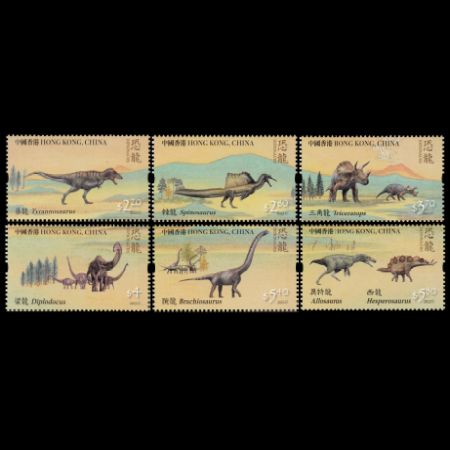
On November 15th 2022, the Post Authority of Hong Kong issued a set of six stamps, a Mini-Sheet and related philatelic products under the theme of "Dinosaurs" to showcase several species of dinosaurs from the Jurassic and Cretaceous Periods.
Unlike the stamp set "Chinese Dinosaurs" from 2014, the 2022 set shows dinosaurs from North America, Africa, and Europe.
Dinosaurs are one of the most fascinating and mysterious animals on earth so far. They appeared as early as 230 million years ago and went extinct 66 million years ago. Since the discovery of dinosaur fossils in the 19th century, paleontologists have been working hard to understand what these prehistoric creatures really looked like and explore the ancient world dominated by dinosaurs.
Dinosaurs proliferated during the Cretaceous Period (about 145 million to 66 million years ago) and the Jurassic Period (about 201 to 145 million years ago). This set of stamps includes seven species of dinosaurs, each featuring one or two dinosaur species, including Tyrannosaurus, Spinosaurus and Triceratops from the Cretaceous Period, and Diplodocus, Brachiosaurus, Allosaurus and Hesperosaurus from the Jurassic Period.
 |
| Hong Kong Science Museum on stamp from 1993 (part of "Science & Technology" set of 4 stamps). MiNr.: 697, Scott: 680 |
The exhibition aims to help visitors learn from the past to combat climate change and preserve earth’s biodiversity.
The exhibition boasts an unrivalled amount of original fossil material, some of the most complete fossil skeletons in the world, world-class artwork, cutting-edge 3D renderings and the first scientifically accurate reconstructions of the world's largest predatory dinosaur and the world's largest flying creature.
The team behind the exhibits took a unique approach to this project, blending the world of scientific research, storytelling and unique scenography to create an exhibition that reveals entirely novel scientific insights and provides immersive experiences along with some dynamic skeletal mounts.
| Cretaceous | Jurassic |
|
During the Cretaceous Period (145 million to 66 million years ago), the continents continued to divide,
and flowering plants emerged. Various dinosaurs continued to dominate the planet, including the bone-crushing Tyrannosaurus, the water-thirsty Spinosaurus, and the sturdy-headed Triceratops. |
During the Jurassic Period (201 to 145 million years ago), the ancient supercontinent "Pangea" was breaking up. Plants flourished in warmer climates, and dinosaurs evolved into different species, including the gigantic Diplodocus and Brachiosaurus, the mighty predator Allosaurus, and the armoured Hesperosaurus. |
|
$2.20 Stamp - Tyrannosaurus - means "tyrant lizard" Diet: carnivorous Fossils of the genus have been found in western North America Tyrannosaurus is the most iconic dinosaur. Tyrannosaurus was invincible when hunting, and evolved with a number of powerful weapons. Tyrannosaurus teeth are the size of bananas and shaped like blades, which are stronger than those of other predatory dinosaurs; Tyrannosaurus jawbones are strong and powerful, and their bite force surpasses that of many dinosaurs, enough to crush the huge bones of Triceratops. In addition, compared with predatory dinosaurs of similar size, Tyrannosaurus has a larger brain and clear vision. Micro-CT scans of the braincase show that the part of the brain responsible for the sense of smell was large. Tyrannosaurus likely had a very keen sense of smell. These characteristics allowed Tyrannosaurus to dominate the Late Cretaceous Period. $2.80 Stamp - Spinosaurus - means "spine lizard" Diet: carnivorous (mainly fish) Fossils of the genus have been found in North Africa. Spinosaurus can swim, dive and hunt. Spinosaurus' tail is like an oar, which can propel its huge body forward in the water. Long, narrow jaws that close quickly and conical teeth are ideal for catching slippery prey such as fish. In addition, Spinosaurus' nostrils were located further back on the skull, allowing it to breathe even when most of the head was submerged in water. $3.70 Stamp - Triceratops - means "three-horned face" Diet: herbivorous Fossils of the genus have been found in North America. Triceratops are ceratopsians. Ceratopsians had similar tails, bodies, and limbs, but more diverse heads. They have more teeth and complex dentitions for chewing plants, as well as spectacular head shields, horns and other decorative structures. These features are both aesthetically pleasing and defensive. The biggest feature of Triceratops is the three huge horns on its head, and its large and strong head shield is better than most ceratopsians. |
$4 Stamp - Diplodocus - means "double beam" Diet: herbivorous Fossils of the genus have been found in mid-western North America. Diplodocus has a small head, relatively simple tooth structure, can tear plants from branches to eat, and has a large digestive system to process food. Diplodocus' heart was large and strong, pumping blood up its extremely long neck; its complex system of air sacs reduced body weight and kept the respiratory system working efficiently, similar to modern birds. The hind limbs of Diplodocus were longer than the front limbs, and the center of gravity was relatively close to the pelvis, so it could stand on the hind limbs and scare off predators. $5.40 Stamp - Brachiosaurus - means "deep chest" Diet: herbivorous Fossils of the genus have been found in Africa and Europe. Brachiosaurus is a sauropod dinosaur. By comparing the shape and replacement rate of sauropods' teeth, we can understand their habits and ecology. Compared to other dinosaurs, which had complex dentitions to grind food, sauropods had relatively simple teeth that ripped young plants from branches as they fed. The forelimbs of Brachiosaurus were longer than the hind limbs, and the height was amazing. $5.50 Stamp - Allosaurus and Hesperosaurus Diet: carnivorous (Allosaurus), herbivorous (Hesperosaurus) Allosaurus - means "different lizard", fossils of the genus have been found in North America and Portugal. Hesperosaurus - meaning "western lizard", fossils of the genus have been found in USA (Wyoming and Montana states). Allosaurus was one of the most feared predatory dinosaurs, with strong jawbones and sharp claws that made it easy to kill prey. Hesperosaurus belong to the stegosaur family and has evolved long spines at the end of its tail, which can pierce the attacker with the flesh. Just swinging its powerful tail from side to side was enough to scare off many predators. From bite marks and skeletal scars on the fossils, we know that armored dinosaurs such as Hesperosaurus had dangerous fights with predatory dinosaurs such as Allosaurus. |
Products and associated philatelic items
| Mini-Sheet | Stamp Sheets of 25 | Presentation Packs |
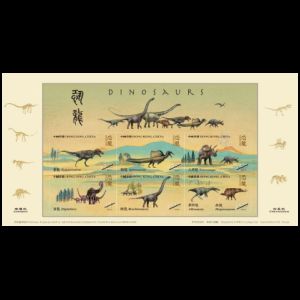 |
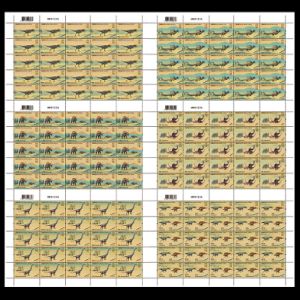 |
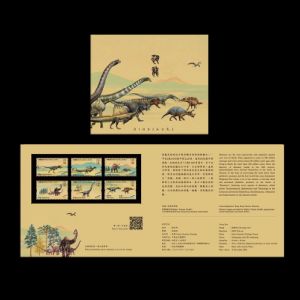 |
| FDC | Postal Stationeries (Prepaid Postcards) | |
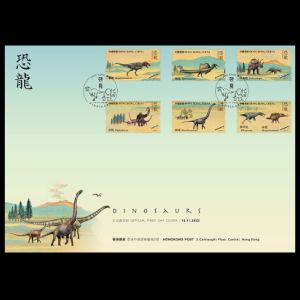 |
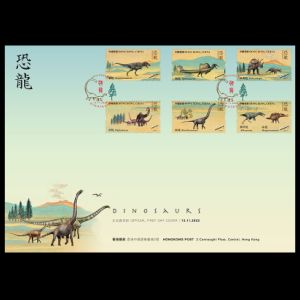 |
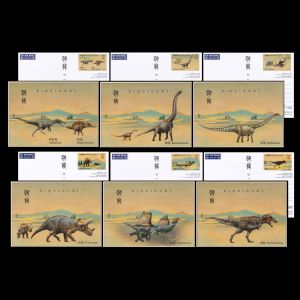 |
| FDC | ||
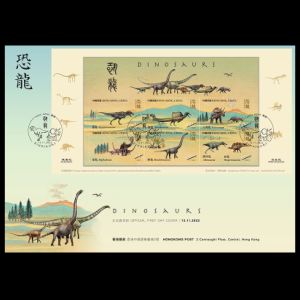 |
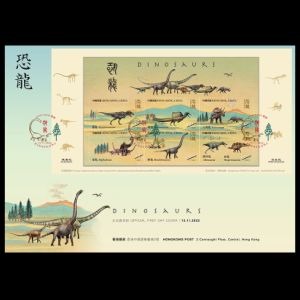 |
|
References:

|
- Technical details and official press release: Hong Kong Post
- Dinosaurs depicted on the stamps:
- “The Big Eight – Dinosaur Revelation” exhibition at the Hong Kong Science Museum: official site of the Hong Kong Science Museum
Acknowledgements:
Many thanks to Dr. Peter Voice from Department of Geological and Environmental Sciences, Western Michigan University, for the draft page review and his very valuable comments.
| <prev |